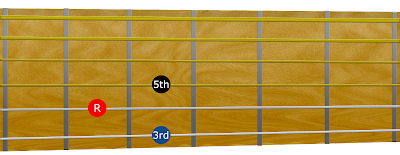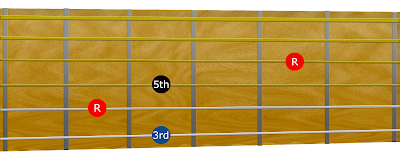The next chord shape we’re going to look at in this lesson series is the D shape.
Just like the other chord shapes, you can use this to play any chord on the fretboard.
In this lesson, you’re going to learn how to:
- join the E shape and the D shape on the fretboard
- create and move chords using the D shape
- play major chords with the D shape
- change major chords into minor chords with the D shape
Just like the other shapes, the D chord is linked to the shape that comes before it, the E shape.
To move from the E shape to the D shape, you replace your annular finger in the E shape, with your index finger in the D shape. This effectively then becomes the nut of your guitar, and leaves the rest of your fingers to play the D shape.
Your root note is in the middle of this triad. So whichever note that index finger is on, is going to be the name of the chord you are playing. So you can play a D, and E, F, and so on.
The second way you can use the D shape is to use your index finger to replace the nut of the guitar again. If you do this, you don’t need to play your top (or thinnest) string.
Because you are now using your little finger, and your ring finger to play the second and third strings, this frees up your middle finger to help out with the barre if you need it.
Guitar practice journal
Download the Guitar Practice Tracker today. It will help to keep you motivated and give you a visual representation of your progress, and areas of focus throughout the year.
A guitar journal will enable you to:- Set personalised goals and monitor your progress
- Identify the number of hours or days you've spent on a particular skill
- Provide a quick reference to the notes and chords in a particuar key
- List the songs you know and sort by key, capo placement, artist, and chord progression
- Link directly to your favourite YouTube videos and tutorials
Download the Guitar Practice Tracker
Photo by Charles Parker


